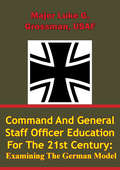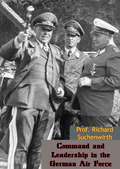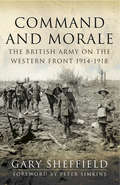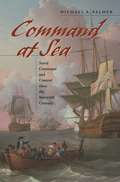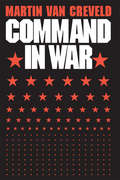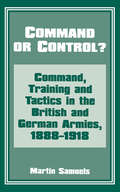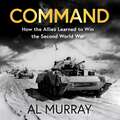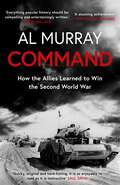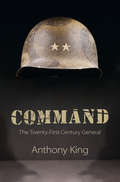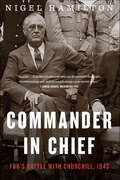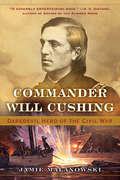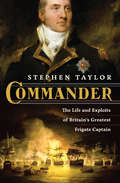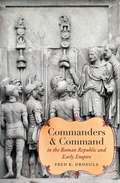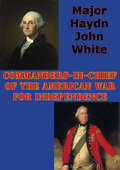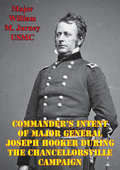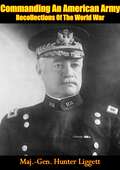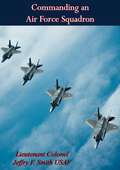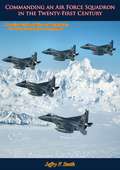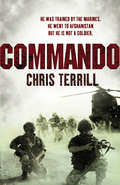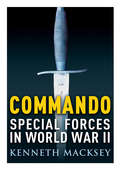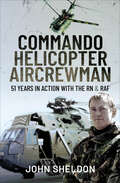- Table View
- List View
Command and General Staff Officer Education for the 21st Century Examining the German Model
by Major Luke G. Grossman USAFEducation has been the foundational cornerstone to every profession and continues to be so in the 21st Century. As a profession, the military is obligated to conduct not only training but also education of the keepers of the profession, the officer corps. Since the rise of large military bodies enabled by the levee en masse and industrialization, armies have required educated officers skilled in both command and staff functions. The Prussian-German model of staff officer education embodied in the Kriegsakademie of the Nineteenth and first half of the Twentieth Century's, was highly regarded and much copied. The education officer received at the Kriegsakademie directly contributed to an efficiently organized and employed Prussian-German Army at the tactical and operational levels. The investment in Kriegsakademie officer education paid huge dividends at Gravelotte-St Privat and Sedan 1870, Tannenberg 1914, Battle of Poland 1939, and the Battle of France 1940, critical first battles.With the rearming of Germany in 1955 came the need for the fledgling Bundeswehr to educate general staff officers. This need was met by establishing the Führungsakademie (German Armed Forces Command and Staff College). The Führungsakademie was created with the same time honored principles that had served general staff officer training previously: careful selection of the most highly qualified and promising officers and a broad based education rigorously applied. However, little information on the current Führungsakademie Education System is available in the English language. This monograph attempts to address this void. The author conducted research and interviews with the faculty, staff, and students at the Führungsakademie in Hamburg, Germany in order to understand and assess the education given to German general staff officer aspirants. The central general staff officer's education course is the National General/Admiral Staff Officers Course.
Command and Leadership in the German Air Force
by Prof. Richard SuchenwirthCommand and Leadership in the German Air Force, first published in 1969, written by Professor Richard Suchenwirth, and revised and edited by Mr. Harry R. Fletcher, is one of a series of historical studies written for the United States Air Force Historical Division by men who had been key officers in, or outstanding authorities on, the German Air Force during World War II.The overall purpose of the series is twofold: 1) To provide the United States Air Force with a comprehensive and, insofar as possible, authoritative history of a major air force which suffered defeat in World War II, a history prepared by many of the principal and responsible leaders of that air force; 2) to provide a firsthand account of that air force’s unique combat in a major war, especially its fight against the forces of the Soviet Union. This series of studies therefore covers in large part virtually all phases of the Luftwaffe’s operations and organization, from its camouflaged origin in the Reichswehr, during the period of secret rearmament following World War I, through its participation in the Spanish Civil War and its massive operations and final defeat in World War II, with particular attention to the air war on the Eastern Front.These studies find their principal authority in the personal knowledge and experience of their authors.
Command and Morale: The British Army on the Western Front 1914–1918
by Gary SheffieldGary Sheffield is one of the most versatile and stimulating of military historians at work today, and this selection of his outstanding essays on the First World War is essential reading for anyone who is keen to broaden their understanding of the subject. For three decades, in a series of perceptive books and articles, he has examined the nature of this war from many angles from the point of view of the politicians and the high command through to the junior officers and other ranks in the front line. Command and Morale presents in a single volume a range of his shorter work, and it shows his scholarship at its best.Among the topics he explores is the decision-making of the senior commanders, the demands of coalition warfare, the performance of Australian forces, the organization and the performance of the army in the field, the tactics involved, the exercise of command, the importance of morale, and the wider impact of the war on British society. Every topic is approached with the same academic rigour and attention to detail which are his hallmarks and which explain why his work has been so influential. The range of his writing, the insights he offers and the sometimes controversial conclusions he reaches mean this thought provoking book will be indispensable reading for all students of the First World War and of modern warfare in general.
Command at Sea: Naval Command and Control since the Sixteenth Century
by Michael A. PalmerCommanders at sea struggle not only with the unpredictability of natural elements, but also with a shroud of uncertainty often referred to as the "fog of war." Over the centuries most admirals yielded to the natural temptation to find in new technologies a means to assert centralized control over their forces. But other commanders have recognized the fog for what it is: a constant level of uncertainty resistant to mere technological solution. In this grand history of naval warfare, Michael Palmer observes five centuries of dramatic encounters under sail and steam. From reliance on signal flags in the seventeenth century to satellite communications in the twenty-first, admirals looked to the next advance in technology as the one that would allow them to control their forces. But while abilities to communicate improved, Palmer shows how other technologies simultaneously shrank admirals' windows of decision. The result was simple, if not obvious: naval commanders have never had sufficient means or time to direct subordinates in battle. Successful commanders as distant as Horatio Nelson (1758-1805) and Arleigh Burke (1901-1996) accepted this reality. They sought solutions to the dilemmas of command in the personal indoctrination of subordinates through discussion, comradeship, and displays of trust and confidence. Such leaders created a commonality of vision and fostered a high degree of individual initiative. Their decentralized approach to command resulted in a resiliency that so often provided the key to success in battle. Palmer's exciting and enlightening history reveals the myriad efforts of naval commanders to navigate the fog of war.
Command in War
by Martin Van CreveldMany books have been written about strategy, tactics, and great commanders. This is the first book to deal exclusively with the nature of command itself, and to trace its development over two thousand years from ancient Greece to Vietnam. It treats historically the whole variety of problems involved in commanding armies, including staff organization and administration, communications methods and technologies, weaponry, and logistics. And it analyzes the relationship between these problems and military strategy. In vivid descriptions of key battles and campaigns—among others, Napoleon at Jena, Moltke’s Königgrätz campaign, the Arab–Israeli war of 1973, and the Americans in Vietnam—Martin van Creveld focuses on the means of command and shows how those means worked in practice. He finds that technological advances such as the railroad, breech-loading rifles, the telegraph and later the radio, tanks, and helicopters all brought commanders not only new tactical possibilities but also new limitations. Although vast changes have occurred in military thinking and technology, the one constant has been an endless search for certainty—certainty about the state and intentions of the enemy’s forces; certainty about the manifold factors that together constitute the environment in which war is fought, from the weather and terrain to radioactivity and the presence of chemical warfare agents; and certainty about the state, intentions, and activities of one’s own forces. The book concludes that progress in command has usually been achieved less by employing more advanced technologies than by finding ways to transcend the limitations of existing ones.
Command or Control?: Command, Training and Tactics in the British and German Armies, 1888-1918
by Martin Samuels Dr Martin SamuelsThis is a comparative study of the fighting systems of the British and German armies in The Great War. Taking issue with revisionist historians, Samuels argues that German success in battle can be explained by their superior tactical philosophy. The book provides a fascinating insight into the development of infantry tactics at a seminal point in the history of warfare.
Command: How the Allies Learned to Win the Second World War
by Al MurrayA unique analysis of the greatest commanders who helped the allies win the Second World War, written by one of the UK's best loved comedians and commentators. He also loves history.Al Murray's passion for military history and the Second World War in particular has always run parallel with his comedy and was brought to the fore with several acclaimed and award-winning television shows and the recent huge success of his podcast We Have Ways of Making You Talk which he hosts with fellow bestselling military author James Holland. In his first serious narrative book, Command showcases Al Murray's passion for this pivotal period in the twentieth century, as he writes an engaging, entertaining and sharp analysis of the key allied military leaders in the conflict. Command highlights the performance and careers of some of the leading protagonists who commanded armies, as well as the lesser-known officers who led divisions, regiments and even battalions for the British, Commonwealth and United States of American armies. By showcasing each combat commander across every major theatre of operations the allies fought in, Murray tells the story of how the Western Allies rebounded from early shocking defeats (Dunkirk and Pearl Harbor) to then victories (El Alamein and D-Day) in its efforts to defeat the Axis forces of Nazi Germany and Japan, and what that tells us about the characters and the challenges that faced them. Command is the book for all fans of Second World War History who appreciate a true enthusiast of the genre with something new and compelling to say.(P) 2022 Quercus Editions Limited
Command: How the Allies Learned to Win the Second World War
by Al MurrayAl Murray's passion for military history and the Second World War in particular has always run parallel with his comedy and was brought to the fore with several acclaimed and award-winning television shows and the recent huge success of his podcast We Have Ways of Making You Talk which he hosts with fellow bestselling military author James Holland. In his first serious narrative book, Command showcases Al Murray's passion for this pivotal period in the twentieth century, as he writes an engaging, entertaining and sharp analysis of the key allied military leaders in the conflict. Command highlights the performance and careers of some of the leading protagonists who commanded armies, as well as the lesser-known officers who led divisions, regiments and even battalions for the British, Commonwealth and United States of American armies. By showcasing each combat commander across every major theatre of operations the allies fought in, Murray tells the story of how the Western Allies rebounded from early shocking defeats (Dunkirk and Pearl Harbor) to then victories (El Alamein and D-Day) in its efforts to defeat the Axis forces of Nazi Germany and Japan, and what that tells us about the characters and the challenges that faced them. Command is the book for all fans of Second World War History who appreciate a true enthusiast of the genre with something new and compelling to say.
Command: The Twenty-First-Century General
by Anthony KingIn the wake of the troubled campaigns in Afghanistan and Iraq, military decision-making appears to be in crisis and generals have been subjected to intense and sustained public criticism. Taking these interventions as a starting point, Anthony King examines the transformation of military command in the twenty-first century. Focusing on the army division, King argues that a phenomenon of collective command is developing. In the twentieth century, generals typically directed and led operations personally, monopolising decision-making. They commanded individualistically, even heroically. As operations have expanded in range and scope, decision-making has multiplied and diversified. As a result command is becoming increasingly professionalised and collaborative. Through interviews with many leading generals and vivid ethnographic analysis of divisional headquarters, this book provides a unique insight into the transformation of command in western armies.
Commanded by the French Duke
by Meriel FullerOne knight to capture her heart! Alinor of Claverstock takes her life in her hands when she rescues Bianca d'Attalens from her stepmother's evil clutches. But when Alinor encounters Bianca's handsome brother, Guilhem, Duc d'Attalens, it's not just her life that's in danger. Alinor finds herself powerless to resist Guilhem and is soon caught up in a perilous web of intrigue and forbidden attraction. An attraction that heightens when they are sent together into enemy territory...
Commander In Chief: FDR's Battle with Churchill, 1943 (FDR at War #2)
by Nigel HamiltonThe astonishing story of FDR’s yearlong, defining battle with Churchill in 1943, as the war raged in Africa and Italy: “Superb.” —Fareed Zakaria, The Washington Post1943 was the year of Allied military counteroffensives, beating back the forces of the Axis powers in North Africa and the Pacific—the “Hinge of Fate,” as Winston Churchill called it. In Commander in Chief, Nigel Hamilton reveals Franklin D. Roosevelt’s true role in this saga: overruling his own Joint Chiefs of Staff, ordering American airmen on an ambush of the Japanese navy’s Admiral Yamamoto, facing down Churchill when he attempted to abandon Allied D-Day strategy (twice). This FDR is profoundly different from the one Churchill later painted. President Roosevelt’s patience was tested to the limit quelling the prime minister’s “revolt,” as Churchill pressured Congress and senior American leaders to focus Allied energy on disastrous fighting in Italy and the Aegean instead of landings in Normandy. Finally, in a dramatic showdown at Hyde Park, FDR had to stop Churchill from losing the war by making the ultimate threat, setting the Allies on their course to final victory. Hamilton masterfully chronicles the clash of nations—and of two titanic personalities—at a crucial moment in modern history.“The author offers plenty of colorful period detail . . . a solid inside view of the strategic thinking that went into the campaign against Hitler as America laid the groundwork for the D-Day invasion the following year.” —Kirkus Reviews (starred review)“Hamilton combines polished writing, a command of various sources, and broad insight in this account of Franklin Roosevelt’s pivotal WWII year.” —Publishers WeeklyIncludes maps
Commander Will Cushing: Daredevil Hero of the Civil War
by Jamie MalanowskiThe lead writer of the New York Times's award-winning "Disunion" series introduces William Barker Cushing, the Civil War's most celebrated naval hero. October 1864. The confederate ironclad CSS Albemarle had sunk two federal warships and damaged seven others, taking control of the Roanoke River and threatening the Union blockade. Twenty-one-year-old navy lieutenant William Barker Cushing hatched a daring plan: to attack the fearsome warship with a few dozen men in two small wooden boats. What followed, the close-range torpedoing of the Albemarle and Cushing's harrowing two-day escape downriver from vengeful Rebel posses, is one of the most dramatic individual exploits in American military history. Theodore Roosevelt said that Cushing "comes next to Farragut on the hero roll of American naval history," but most have never heard of him today. Tossed out of the Naval Academy for "buffoonery," Cushing proved himself a prodigy in behind-the-lines warfare. Given command of a small union ship, he performed daring, near-suicidal raids, "cutting out" confederate ships and thwarting blockade runners. With higher commands and larger ships, Cushing's exploits grow bolder, culminating in the sinking of the Albemarle. A thrilling narrative biography, steeped in the tactics, weaponry, and battle techniques of the Union Navy, Commander Will Cushing brings to life a compelling yet flawed figure. Along with his three brothers, including one who fell at Gettysburg, Cushing served with bravery and heroism. But he was irascible and complicated--a loveable rogue, prideful and impulsive, who nonetheless possessed a genius for combat. In telling Cushing's story, Malanowski paints a vivid, memorable portrait of the army officials, engineers, and politicians scrambling to win the war. But he also goes deeper into the psychology of the daredevil soldier--and what this heroic and tragic figure, who died before his time, can tell us about the ways we remember the glories of war.
Commander: The Life and Exploits of Britain's Greatest Frigate Captain
by Stephen Taylor"Nobody describes a naval battle better than Taylor...a flawless demonstration of the biographer's craft." --Jan Morris, The Guardian Edward Pellew, captain of the legendary Indefatigable, was quite simply the greatest British frigate captain in the age of sail. Left fatherless at age eight, with a penniless mother and five siblings, Pellew fought his way from the very bottom of the navy to fleet command. Victories and eye-catching feats won him a public following. Yet he had a gift for antagonizing his better-born peers, and he made powerful enemies. Redemption came with his last command, when he set off to do battle with the Barbary States and free thousands of European slaves. Opinion held this to be an impossible mission, and Pellew himself, leading from the front in the style of his contemporary Nelson, did not expect to survive. Pellew's humanity, fondness for subordinates, and blind love for his family, and the warmth and intimacy of his letters, make him a hugely engaging figure. Stephen Taylor gives him at last the biography he deserves.
Commanders and Command in the Roman Republic and Early Empire
by Fred K. DrogulaIn this work, Fred Drogula studies the development of Roman provincial command using the terms and concepts of the Romans themselves as reference points. Beginning in the earliest years of the republic, Drogula argues, provincial command was not a uniform concept fixed in positive law but rather a dynamic set of ideas shaped by traditional practice. Therefore, as the Roman state grew, concepts of authority, control over territory, and military power underwent continual transformation. This adaptability was a tremendous resource for the Romans since it enabled them to respond to new military challenges in effective ways. But it was also a source of conflict over the roles and definitions of power. The rise of popular politics in the late republic enabled men like Pompey and Caesar to use their considerable influence to manipulate the flexible traditions of military command for their own advantage. Later, Augustus used nominal provincial commands to appease the senate even as he concentrated military and governing power under his own control by claiming supreme rule. In doing so, he laid the groundwork for the early empire's rules of command.
Commanders-In-Chief Of The American War For Independence
by Major Haydn John WhiteLeadership is an intensely studied subject, and a considerable number of models exist. By reviewing four leadership theories, two German, one British, and one American, a model developed that contained the enduring interrelated tenets of courage, judgment, determination, integrity, vision, and luck.George Washington displayed considerable ability in all these. He had tremendous courage both in battle and in his conviction of a victorious outcome of the war. His judgment above the tactical level was exceptional, and, from limited resources, he developed a standing army and a defensive military strategy, both of which became the cornerstone of victory. He continually frustrated the British. Throughout all the stresses of the war, Washington remained a man of integrity while pursuing a vision of a free and fair republic. His lack of resources forced him to be unconventional. This he achieved by seeking out as much information as possible, so that every favorable opportunity could be exploited and every unfavorable one avoided.William Howe displayed a limited ability in all the aforementioned tenets. Although brave, he lacked the moral conviction required to prosecute an aggressive military campaign. His tactical judgment was good, if ponderous, but he failed to develop this into operational or strategic success. In particular, he failed to focus to destroy Washington's army. Consequently, his efforts lacked tenacity, and he became distracted while showing limited integrity by setting a poor example. His focus became purely his army, rather than his area of responsibility as a whole. His limited vision was consistently complicated by his dual role as both military leader and diplomat, and he failed to address either with vigor. His frustration saw him use slow and conventional tactics which were unsuited to the circumstances, while he consistently failed to exploit his opportunities.
Commander’s Intent Of Major General Joseph Hooker During The Chancellorsville Campaign
by Major William M. Jurney USMCDid "Fighting Joe" Hooker of the Army of the Potomac lose his nerve during the Chancellorsville Campaign of 1863? Perhaps history has failed to recognize Major General Joseph Hooker's true commander's intent for this campaign. Hooker's intent was simple: maneuver forces to Lee's flank and rear in order to force a withdrawal of Confederate troops from Fredericksburg. Hooker had no intention of engaging in a "risky confrontation" with General Robert E. Lee and the Army of Northern Virginia.Hooker's approach for planning his spring offensive would focus the Army of Potomac's efforts toward outmaneuvering Lee's Army of Northern Virginia. Hooker had put forth the idea of moving on Richmond and Lincoln advised him that his objective was Lee's army and not Richmond. Hooker does pursue Lee's army, as the main objective and not Richmond as the President had directed but the means that Hooker pursued to that end are misleading. Hooker entered what he considered the initial stage of his spring offensive at Chancellorsville thinking that he would first defeat Lee's army by maneuver. Prior to Chancellorsville, however, Hooker was already making preparations for driving to Richmond.Hooker had intended to confront Lee with the dilemma of being threatened from all sides. Unfortunately, Hooker had failed to communicate his intentions for his army's movements of May 1, 1863 and confusion ran rampant among his subordinate commanders. Almost exclusively, Hooker developed the actual details of the plan himself. This flaw would result in numerous disconnects in Hooker's plan.Hooker's plan would fail due to his own steadfast belief in the ability of his plan to force Lee to withdraw. To say that Lee defeated the Army of the Potomac is misleading because Lee did not defeat the army, he defeated Hooker as he fought a very effective defensive battle that removed the Federal threat from Virginia due to Hooker's failings as an army commander.
Commanding An American Army Recollections Of The World War
by Major-General Hunter LiggettA detailed account of his service and career from Major-General Hunter Liggett: who commanded 41st Division, then 1st Army Corps, A.E.F. before the entire 1st American Army. A significant and underappreciated leader of the United States war effort during the First World War and a prominent member of the U.S. army command for over four decades.“Lieutenant General Hunter Liggett (March 21, 1857 − December 30, 1935) was a senior United States Army officer. His 42 years of military service spanned the period from the Indian campaigns to the trench warfare of World War I. Additionally, he also identified possible invasion sites in Luzon, particularly Lingayen Gulf, which were used during World War II in 1941 by the Japanese and in 1945 by the United States.Success in brigade commands in Texas and in the Philippines led to his promotion to major general, and selection as commander of the 41st Division in April 1917. The division served in France as part of the American Expeditionary Force. When his division was disestablished, he took command of I Corps.Under Liggett's leadership, the I Corps participated in the Second Battle of the Marne and in the reduction of the Saint-Mihiel salient. In October 1918, as commander of the First United States Army with the rank of lieutenant general in the national army, he directed the final phases of the Meuse-Argonne offensive and the pursuit of German forces until the armistice. After commanding the post-war Army of Occupation, Liggett returned to his permanent rank of major general, and retired in 1921.Throughout most of this period, Liggett's aide-de-camp was James Garesche Ord, a major general in World War II.”-Wiki
Commanding Fire: An Officer’s Life in the 151st Machine Gun Battalion, 42nd Rainbow Division During World War I
by N. P. Parkinson Joel R. ParkinsonCommanding Fire is one officer's story of commanding a machine gun platoon on the battlefields of northern France in 1918. Included are firsthand company and battalion accounts making it the first published history of the 151st Machine Gun Battalion, 42nd Rainbow Division. Every significant American engagement in World War I is covered including action in Lorraine, Champagne, Chateau-Thierry, St. Mihiel, Meuse-Argonne, and service in the Army of Occupation. Lieutenant Parkinson recounts defense and attack, trench and open warfare, night and day operations, waiting and marching, monotony and terror, daily life and deadly action. He traces the development of machine gun tactics and tells previously unknown stories about the Rainbow Division and one of its brigade commanders, Douglas MacArthur.
Commanding Military Power
by Ryan GrauerCommanding Military Power offers a new explanation of why some armed forces are stronger than others. Ryan Grauer advances a 'command structure theory' which combines insights from organization theory, international relations, and security studies literatures to provide a unique perspective on military power. Specifically, armed forces organized to facilitate swift and accurate perception of and response to battlefield developments will cope better with war's inherent uncertainty, use resources effectively, and, quite often, win. Case studies of battles from the Russo-Japanese War, Chinese Civil War and Korean War, based on new archival research, underscore the argument, showing that even smaller and materially weaker militaries can fight effectively against and defeat larger and better endowed adversaries when they are organizationally prepared to manage uncertainty. That organization often matters more than numbers and specific tools of war has crucial implications for both contemporary and future thinking about and efforts to improve martial strength.
Commanding Voices of Blue & Gray: General William T. Sherman, General George Custer, General James Longstreet, & Major J.S. Mosby, Among Others, in Their Own Words
by Brian M. ThomsenThe agony and anguish of the War Between the States affected all aspects of American life. Many quarters suffered, but one in particular seemed to prosper in the postwar aftermath: the publishing industry. Though the success of Personal Memoirs by Ulysses S. Grant (as published by Mark Twain) is a clear milestone in publishing's history of bestsellers, it was only one of many highly successful Civil War memoirs penned and published by veterans in the postwar years.Never before in America had such a plethora of eyewitness accounts of a war existed, nor so many by those in a position of command.Drawing on the best of these accounts, most of them long out of print, Commanding Voices of Blue & Gray presents in a single volume the personal words of these leaders and provides an overview of the command experience in the Civil War.Selections include:General William Tecumseh Sherman on his infamous march through GeorgiaGeneral George B. McClellan on the battle of Antietam and the legendary lost order that should have tipped him off to Lee's plansGeneral George Armstrong Custer's experience of going straight from studying at West Point to the BattlefieldGeneral (CSA) James Longstreet on serving under Robert E. LeeGeneral (CSA) G. Moxley Sorrel on serving under General James LongstreetMajor (CSA) J. S. Mosby on the South's guerrilla campaignGeneral (CSA) Jubal Early's memoir of the last year of the warAt the Publisher's request, this title is being sold without Digital Rights Management Software (DRM) applied.
Commanding an Air Force Squadron
by Lieutenant Colonel Jeffry F. Smith USAFThe privilege of commanding an Air Force squadron, despite its heavy responsibilities and unrelenting challenges, represents for many Air Force officers the high point of their careers. It is service as a squadron commander that accords true command authority for the first time. The authority, used consistently and wisely, provides a foundation for command. As with the officer’s commission itself, command authority is granted to those who have earned it, both by performance and a revealed capacity for the demands of total responsibility. But once granted, it much be revalidated every day. So as one assumes squadron command, bringing years of experience and proven record to join with this new authority, one might still need a little practical help to success with the tasks of command. This book offers such help. “Commanding an Air Force Squadron” brings unique and welcome material to a subject other books have addressed. It is rich in practical, useful, down-to-earth advice from officers who have recently experienced squadron command. The author does not quote regulations, parrot doctrine, or paraphrase the abstractions that lace the pages of so many books about leadership. Nor does he puff throughout the manuscript about how he did it. Rather, he presents a digest of practical wisdom based on real-world experience drawn from the reflection of many former commanders from any different types of units. He addresses all Air Force squadron commanders, rated and nonrated, in all sorts of missions worldwide. – Print ed.
Commanding an Air Force Squadron in the Twenty-First Century: A Practical Guide Of Tips And Techniques For Today's Squadron Commander
by Jeffry F. SmithThe opportunity to command is a tremendous honor and responsibility and unquestionably will be one of the most significant roles of your Air Force career. The very nature of command is unique to the military; there is no civilian equivalent for this level of trust, authority, and responsibility. The essence of command is leadership, and your example will set the standard for your entire organization. For this reason, command is reserved for those individuals exhibiting only the highest levels of integrity, selflessness, and excellence.Leadership is not accomplished from behind the desk or by way of E-mail; rather, effective leadership requires you to lead from out front. Since the responsibilities of such leadership may appear daunting to first-time commanders, our Air Force places significant emphasis on precommand training to ensure your readiness for these new responsibilities. Immerse yourself in the available training to ensure you fully understand the rules of engagement.There is much to learn from the insights, experiences, and recommendations of previous commanders. Lt.-Col. Jeff Smith’s Commanding an Air Force Squadron in the Twenty-First Century provides some excellent perspectives from current and graduated commanders to help set your course and prepare you for the best job in the Air Force.
Commando
by Chris TerrillChris Terrill is a man in search of his limit. He's 55 years old. He is not a soldier. He is being trained by the Royal Marines and he is going to Afghanistan. The only difference is that instead of a gun, Chris will be holding a camera and filming the whole ordeal for a major TV series.The Royal Marines Commando training base in Lympstone Devon, has a famous motto: '99.9% need not apply'. Of those who start training, after a very tough selection process, nearly 50% fail to make it through the most gruelling physical tests of any armed forces in the world in an eight month training regime. The elite who do eventually pass out are generally eighteen years old and at the peak of physical condition. But Chris Terrill is the exception: this book will tell of his heroic struggle to become the oldest man to win the coveted Royal Marines Commando Green Beret and enter the record books.And after six months of hell, what next? Chris will follow the raw recruits on a tour to Southern Afghanistan. He will tell the story in book and film of the fears and hopes of the youngsters as they are plunged into one of the planet's most dangerous wars in the outlaw mountain terrain of Helmand Province. He will tell of ferocious battles against the Taliban, of firefights, of jaw-dropping heroism, British sang froid and humour and tragedy as causalities are suffered -- all from the unique perspective of a civilian who has achieved the ultimate accolade: to be accepted as an honorary Royal Marines Commando. Commando is a brilliant account of modern war on the front line.
Commando
by Kenneth Macksey'Commando', the history Commandos and small-scale raids during World War II, is a gripping narrative, tracing the actions of the fearless men who served as Allied commandos for the Combined Operations department during the war. Kenneth Macksey offers the details of St Nazaire, Bruneval, Dieppe as well as the key players, such as Stirling, Lovat and Carlson. Macksey skilfully provides a study of the lesser-known figures, such as Edson, Appleyard and Pickney, bringing to life their courage and determination while celebrating the sailors who enabled the raiders to reach their destinations.
Commando Helicopter Aircrewman: 51 Years in Action with the RN & RAF
by John SheldonA veteran aircrewman recounts his over five decades of service to the British military in this exciting memoir. This is the remarkable story of one man&’s service in the Royal Navy, RAF and the Royal Naval Reserve Air Branch of the Fleet Air Arm. It is a flying career which lasted for an impressive 51 years and in which Warrant Officer Class 1 John Sheldon amassed over 8,000 hours in the air. Having joined the Royal Navy in 1968, as a fifteen-year-old boy entrant not long out of school, John was recruited into the Fleet Air Arm as a junior electrician. He went on to become a Commando Aircrewman and flew in all types of service helicopters and in all of their roles, from Arctic training in Norway to the balmy Mediterranean and the wilds of Canada. Having initially been involved in the evacuation of Cyprus and the Turkish invasion in 1974, in which his helicopter had to recover bodies from the water with a sprawl net, John went on to serve in Northern Ireland, was deployed to the South Atlantic in the Falklands War, where he operated from HMS Fearless and helped lift survivors from the RFA Sir Galahad tragedy, undertook a tour in Lebanon, and then saw action during the First Gulf War, in Bosnia, Sierra Leone and then in Afghanistan. In his extraordinary career, John was tasked with going around the UK undertaking aerial displays to support recruitment campaigns for the Royal Navy and Royal Marines, as well as completing several tours as a Search and Rescue Aircrewman, Anti-Submarine Operator and also as an RN/RAF Test Aircrewman at the Rotary Wing Test Squadron at Boscombe Down. This unique memoir covers the military action that John encountered, the many incidents and close shaves he was involved in, and the friends he lost during his long and illustrious career.Praise forCommando Helicopter Aircrewman &“This is an honest, readable, self-effacing record of an interesting career.&” —Aeroplane Magazine &“The amazing military career of John Sheldon – inspirational and above all, true.&” —Books Monthly
